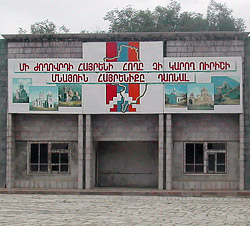After 14 years, I still remember that day in May when I entered “Yerkir” daily edition to find out news about Karabakh. A couple of days before that, I kept hearing citizens of Yerevan talking about how Armenian armed forces would soon liberate Shushi. Some were even predicting a ceasefire with the famous phrase “Whoever loves Shushi, loves Karabakh.”
The offices of the edition were empty. I could hear laugher and screaming coming from the chief editor’s office. It was clear that the Armenians had liberated Shushi. After a drink and congratulating each other, former chief editor of “Yerkir” daily Aghvan Vartanyan, who is currently the Minister of Labor and Social Issues of Armenia, asked me to help them. I remember the assignment: I had to interview leader of the National Democratic union and former member of the “Karabakh” committee Vazgen Manukyan.
The next day I was at Vazgen Manukyan’s house and we were talking about the liberation of Shushi. The leader of the NDU, who was an oppositionist at the time, accused the former authorities of not organizing a ceremony for the liberation. He said that the authorities had to bring the people out to the street, give them a chance to express their joy, which would eventually lead to a sense of national dignity. He felt pity that they didn’t do that.
I went to Shushi in 1993 for the first time. It looked like no-man’s land-no homes, no light, burnt houses. There was no sign of life anywhere. We were walking on the empty streets thinking that this city lost its past and its future. I remembered my visit to the “Yerkir” daily edition that day too, hearing the news of the liberation, my assignment to take an interview and Vazgen Manukyan’s pity for why we didn’t celebrate.
A couple of years later, when Shushi started to get populated, I was present at the opening of the school named after novelist Muratsan in Shushi. The students were standing next to the building constructed through the efforts of an Armenian organization from the Diaspora. There was a crowd of parents and gatherers nearby. Suddenly, dust rose in the air. Twenty Jeeps, Mercedes Benz, BMWs, Nissans and some Soviet Volga and Niva cars entered the school yard. President of Armenia Robert Kocharyan and President of Karabakh Arkadi Ghukassyan had come to officially open the school.
The children sang, teachers made their speeches, the presidents made their official speeches and as they approached the pedestal, they removed the sheet covering the bust. When the bust appeared, I remembered a mistake that Armenian students often make. When asked where Muratsan was born, many would say Tsovagyugh village because they had seen the bust of the novelist on the coast of Sevan Lake where the village is located. Then I realized that I had seen that bust somewhere.
“This bust is very familiar,” I said to the person standing next to me who looked like he was an authority figure judging from his costume and tie.
“You must have seen it,” said the man after a while and added, “it was standing in Stepanakert a couple of days ago.”
“Near Muratsan street?” I asked.
“Yes”
“Is the sculpting of this bust included in the school’s budget?”
“I don’t know.”
Then the man told me that years ago, head of the Karabakh regional board Gevorgov had somehow convinced the Baku authorities to install at least one bust in the birthplace of the novelist. Muratsan was born in Shushi, but they installed the bust in Stepanakert.
“Gevorgov personally followed up on the sculpting and installment of the bust,” said the man.
The last time I was in Shushi was early July. It was noon. It looked like a desert. The only living soul near the Ghazanchetsots church was the candle-selling lady who was waiting for tourists. I walked the deserted streets of Shushi. I was looking for a resident of Shushi and I met a beggar. Where can’t you see a beggar? Then I met another beggar, and then another, and another…
I remembered my interview with Vazgen Manukyan-the joy of victory, national dignity. Then I remembered the wonderful performance of the Chamber Orchestra of Armenia near one of the community colleges of Shushi-there were lights, sounds of different instruments, the look on people’s faces and the cool, night air. Director of the Armenian Chamber Orchestra Aram Gharabekyan was telling journalists that Shushi must become a center for world art.
It would be hard for me to remember all this and write an article if it wasn’t for the article on findings in Shushi I read recently:
“The findings prove that there were people living on a plateau in Shushi even before the Bronze Age. There are signs of Armenian life too.”
After reading these lines, I understood why Muratsan’s bust was moved from Stepanakert to Shushi. A thousand years later, scientists will find that bust and show the international community the traces of Armenians. That will probably be after the reincarnation of Bryza, Fasie and Merzlyakov.

